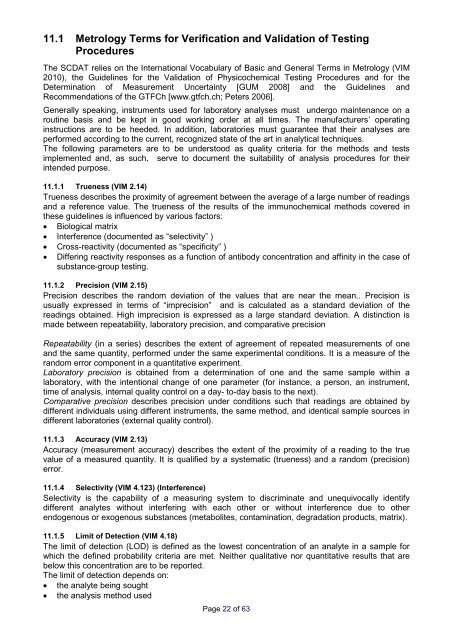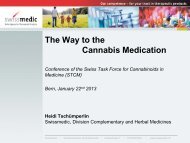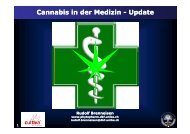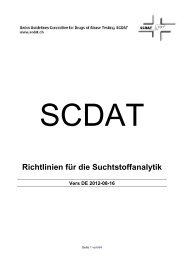Guidelines for Drugs of Abuse Testing vers 2012 - Brenneisen
Guidelines for Drugs of Abuse Testing vers 2012 - Brenneisen
Guidelines for Drugs of Abuse Testing vers 2012 - Brenneisen
Create successful ePaper yourself
Turn your PDF publications into a flip-book with our unique Google optimized e-Paper software.
11.1 Metrology Terms <strong>for</strong> Verification and Validation <strong>of</strong> <strong>Testing</strong><br />
Procedures<br />
The SCDAT relies on the International Vocabulary <strong>of</strong> Basic and General Terms in Metrology (VIM<br />
2010), the <strong>Guidelines</strong> <strong>for</strong> the Validation <strong>of</strong> Physicochemical <strong>Testing</strong> Procedures and <strong>for</strong> the<br />
Determination <strong>of</strong> Measurement Uncertainty [GUM 2008] and the <strong>Guidelines</strong> and<br />
Recommendations <strong>of</strong> the GTFCh [www.gtfch.ch; Peters 2006].<br />
Generally speaking, instruments used <strong>for</strong> laboratory analyses must undergo maintenance on a<br />
routine basis and be kept in good working order at all times. The manufacturers’ operating<br />
instructions are to be heeded. In addition, laboratories must guarantee that their analyses are<br />
per<strong>for</strong>med according to the current, recognized state <strong>of</strong> the art in analytical techniques.<br />
The following parameters are to be understood as quality criteria <strong>for</strong> the methods and tests<br />
implemented and, as such, serve to document the suitability <strong>of</strong> analysis procedures <strong>for</strong> their<br />
intended purpose.<br />
11.1.1 Trueness (VIM 2.14)<br />
Trueness describes the proximity <strong>of</strong> agreement between the average <strong>of</strong> a large number <strong>of</strong> readings<br />
and a reference value. The trueness <strong>of</strong> the results <strong>of</strong> the immunochemical methods covered in<br />
these guidelines is influenced by various factors:<br />
• Biological matrix<br />
• Interference (documented as “selectivity” )<br />
• Cross-reactivity (documented as “specificity” )<br />
• Differing reactivity responses as a function <strong>of</strong> antibody concentration and affinity in the case <strong>of</strong><br />
substance-group testing.<br />
11.1.2 Precision (VIM 2.15)<br />
Precision describes the random deviation <strong>of</strong> the values that are near the mean.. Precision is<br />
usually expressed in terms <strong>of</strong> “imprecision” and is calculated as a standard deviation <strong>of</strong> the<br />
readings obtained. High imprecision is expressed as a large standard deviation. A distinction is<br />
made between repeatability, laboratory precision, and comparative precision<br />
Repeatability (in a series) describes the extent <strong>of</strong> agreement <strong>of</strong> repeated measurements <strong>of</strong> one<br />
and the same quantity, per<strong>for</strong>med under the same experimental conditions. It is a measure <strong>of</strong> the<br />
random error component in a quantitative experiment.<br />
Laboratory precision is obtained from a determination <strong>of</strong> one and the same sample within a<br />
laboratory, with the intentional change <strong>of</strong> one parameter (<strong>for</strong> instance, a person, an instrument,<br />
time <strong>of</strong> analysis, internal quality control on a day- to-day basis to the next).<br />
Comparative precision describes precision under conditions such that readings are obtained by<br />
different individuals using different instruments, the same method, and identical sample sources in<br />
different laboratories (external quality control).<br />
11.1.3 Accuracy (VIM 2.13)<br />
Accuracy (measurement accuracy) describes the extent <strong>of</strong> the proximity <strong>of</strong> a reading to the true<br />
value <strong>of</strong> a measured quantity. It is qualified by a systematic (trueness) and a random (precision)<br />
error.<br />
11.1.4 Selectivity (VIM 4.123) (Interference)<br />
Selectivity is the capability <strong>of</strong> a measuring system to discriminate and unequivocally identify<br />
different analytes without interfering with each other or without interference due to other<br />
endogenous or exogenous substances (metabolites, contamination, degradation products, matrix).<br />
11.1.5 Limit <strong>of</strong> Detection (VIM 4.18)<br />
The limit <strong>of</strong> detection (LOD) is defined as the lowest concentration <strong>of</strong> an analyte in a sample <strong>for</strong><br />
which the defined probability criteria are met. Neither qualitative nor quantitative results that are<br />
below this concentration are to be reported.<br />
The limit <strong>of</strong> detection depends on:<br />
• the analyte being sought<br />
• the analysis method used<br />
Page 22 <strong>of</strong> 63






